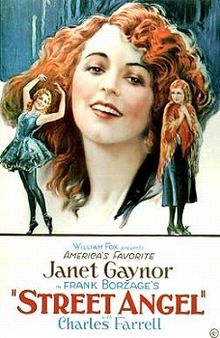
I am planning on taking a course on Coursera called The Language of Hollywood: Storytelling, Sound, and Color in February. The course specifies a list of movies to watch and as such I am slowly working through that list. As I watch them, I’ll write about them and this 1928 silent film is the first of these.
While I wasn’t dreading the experience, I wasn’t exactly looking forward to it either. 1928 feels like so distant in cinematic terms that it might as well be a mythical age, so long ago that Janet Gaynor won the very first Oscar for Best Actress for her performances in three separate films, one of which is this one. So long ago that the title card says “William Fox Presents”, the William Fox who founded Fox Film Corporation, the ancestor of today’s 20th Century Fox. There is every reason to believe that while the film may be important for historical reasons, it may not be very entertaining to modern audiences.
Yet right from the moment when the camera pans down onto the fake Naples and the hapless Angela and her mother, Street Angel had no difficulty drawing me into its story. Yes, there is a theatricality to the performances that we’re not used to. That’s what happens when you don’t have dialogue and you need to convey emotions and even thoughts through facial expressions and body language alone. But even though it feels more like a play than a film, we had no problems empathizing with the characters or being embroiled in their lives.
There’s also a lot of elegance in how they tell what is essentially a very simple story. For example, my wife wondered why an American film with predominantly American actors would set this in Naples, Italy. One reason might be to accentuate the timeless and universal quality of its story. Having it set in contemporary 1920s America would make it feel too real, such that the melodramatic performances and set-pieces would feel unnatural. This way, visual tricks like having the bars of a prison cell cast shadows in a corridor and having the lovers bump into each other amidst a fog, that would otherwise feel artificial work perfectly. Also check out the moustaches on those Italian policemen!
Of course, there are places where the melodrama goes too far for my tastes. The dinner scene in the house is a fantastic one with Angela’s anxiety being played against Gino’s easy confidence, but it goes on for far too long. Another annoyance is the unearned ending. As my wife commented, the film would have felt more powerful and truer to itself, if it had ended in tragedy. I also found myself chortling at the moral sensibilities on display. A couple falls in love in a travelling circus, runs away to be together but rents separate houses because they aren’t married yet?
Overall while it isn’t anywhere close to the best of what I’ve seen recently, Street Angel did turn out to be a surprisingly accessible and entertaining watch just based on its own merits. That it has historical significance above and beyond these is just icing on the cake. Now I actually look forward to the other films on the course’s list.
3 thoughts on “Street Angel (1928)”